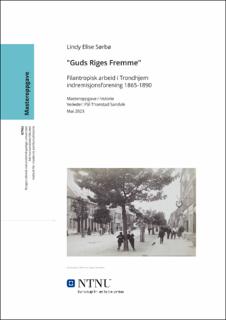| dc.contributor.advisor | Sandvik, Pål Thonstad | |
| dc.contributor.author | Sørbø, Lindy Elise | |
| dc.date.accessioned | 2023-07-01T17:19:39Z | |
| dc.date.available | 2023-07-01T17:19:39Z | |
| dc.date.issued | 2023 | |
| dc.identifier | no.ntnu:inspera:144861566:37601537 | |
| dc.identifier.uri | https://hdl.handle.net/11250/3075166 | |
| dc.description.abstract | Denne studien omhandler Trondhjem indremisjonsforenings arbeid for fattige og syke i perioden 1865-1890, og tar utgangspunktet i foreningens egne årsberetninger fra samtiden. Hensikten er å ytteligere belyse de religiøs-filantropiske virksomhetene på 1800-tallet gjennomn å studere Trondhjem indremisjon. Det er hovedsakelig tre av årsberetningenes sakspunkter som blir analysert. Dette er indremisjonsforeningens fattigpleie, arbeidshjelp og diakonissegjerning.
Både fattigpleien og arbeidspleien er en av indremisjonsforeningens tidligste tiltak for å hjelpe Trondhjems fattige. Byen ble systematisk delt opp i distrikter med egne tilsynsmenn for å organisere fattigpleien på best mulig måte. Hver jul ble det holdt en stor juleuttdelig med mat og klær til de trengede. For fattige arbeidsløse kvinner opprettet foreningen en arbeidshjelp hvor de fikk materialer til å sy, strikke og veve og lønn for produktet. En annen del av foreningens arbeid handlet om kvinnelige pleiersker som de fikk fra Diakonisseanstalten i Christiania. Disse var utdannede kvinner som arbeidet på sykehus og i hjem hos fattige med å stelle syke.
Ved å undersøke foreningens arbeid i detalj, avdekkes flere ulike aspekter innenfor fattigarbeidet, slik som fattigdomssyn, kjønnsperspektiv og arbeidets utvikling gjennom foreningens første 25 år. Studien bidrar dermed til en bedre forståelse av av filantropiske bevegelser og deres betydning for samfunnet i begynnelsen av det moderne Norge. | |
| dc.description.abstract | This study examines the work of Trondhjem indremisjonsforening (Trondhjem´s Inner Mission Association) for the poor and sick during the period 1865-1890. The study is based om the association´s annual reports from the time. The purpose is to further illuminate the religious-philanthropic activities that operated in the early modern period of Norway. To do so, the study will focus on especially three ways the association worked for the poor: the care-work, the work-assistance and work of the deaconesses.
Both the care for the poor and labor-assistance were among the associations earliest initiatives to aid the poor I Trondhjem. To organize the care in the best possible way, the city was divided into districts with their own supervisors, Additionally, a large distribution of food and clothing was held every Christmas for the poor. For unemployed women, the association established a labor-assistance program where they were provided materials to sew, knit and weave, and were paid for their products. The association also recived support form educated female nurses from Diakonisseanstalten (the Deaconess Institute) of Christiania, who worked in hospitals and homes of the poor to care for the sick.
By delving into the association´s work in detail, this study reveals a variety of aspects related to its work for the poor, including the poverty debate, gender perspectives and the evolution of the inner mission´s work. The findings in this study contribute to a deeper understanding of philanthropic movements and their significance for society during the early years of modern Norway. | |
| dc.language | nob | |
| dc.publisher | NTNU | |
| dc.title | "Guds Riges Fremme": Filantropisk arbeid i Trondhjem indremisjonsforening 1865-1890 | |
| dc.type | Master thesis | |
